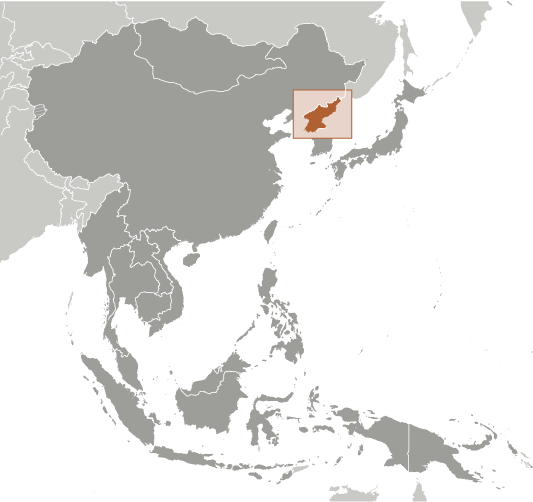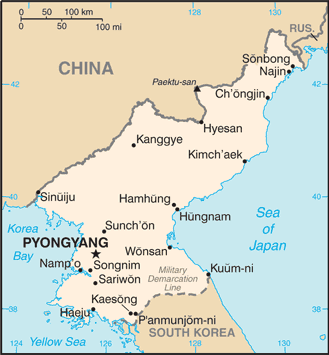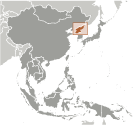
|
|
Advertisements:
People And SocietyNationality
Noun Korean(s)
Adjective Korean Ethnic groups
Racially homogeneous; there is a small Chinese community and a few ethnic Japanese Languages
Korean
Religions
Traditionally Buddhist and Confucianist, some Christian and syncretic Chondogyo (Religion of the Heavenly Way) Note Autonomous religious activities now almost nonexistent; government-sponsored religious groups exist to provide illusion of religious freedom Population World Ranking: 49
24,589,122 (July 2012 est.)
Age structure
0-14 years
22.4% (male 2,766,006/female 2,700,378) 15-64 years 68.6% (male 8,345,737/female 8,423,482) 65 years and over 9.1% (male 738,693/female 1,483,196) (2011 est.) Median age
Total 33 years
Male 31.4 years Female 34.7 years (2012 est.) Population growth rate World Ranking: 149
0.535% (2012 est.)
Birth rate World Ranking: 136
14.51 births/1,000 population (2012 est.) Death rate World Ranking: 65
9.12 deaths/1,000 population (July 2012 est.) Net migration rate World Ranking: 115
-0.04 migrant(s)/1,000 population (2012 est.) Urbanization
Urban population 60% of total population (2010)
Rate of urbanization 0.6% annual rate of change (2010-15 est.) Sex ratio
At birth 1.05 male(s)/female
Under 15 years 1.03 male(s)/female 15-64 years 0.99 male(s)/female 65 years and over 0.51 male(s)/female Total population 0.94 male(s)/female (2011 est.) Maternal mortality rate World Ranking: 82
81 deaths/100,000 live births (2010) Infant mortality rate World Ranking: 77
Total 26.21 deaths/1,000 live births
Male 29.05 deaths/1,000 live births Female 23.24 deaths/1,000 live births (2012 est.) Life expectancy at birth World Ranking: 151
Total population 69.2 years
Male 65.34 years Female 73.24 years (2012 est.) Total fertility rate World Ranking: 128
2.01 children born/woman (2012 est.) Health expenditures World Ranking: 189
2% of GDP (2009)
Physicians density
3.29 physicians/1,000 population (2003) Hospital bed density
13.2 beds/1,000 population (2002) Hiv/aids - adult prevalence rate
NA
Hiv/aids - people living with hiv/aids
NA
Hiv/aids - deaths
NA
Children under the age of 5 years underweight World Ranking: 33
20.6% (2004)
Education expenditures
NA
Literacy
Definition
Age 15 and over can read and write Total population 99%Male 99% Female 99% (1991 est.)
Comments
Add a new comment: |
Advertisement
Members area
North Korea (Pyongyang):
 
GPS points from North Korea (Pyongyang)
|
||||||||

 An independent kingdom for much of its long history, Korea was occupied by Japan beginning in 1905 following the Russo-Japanese War. Five years later, Japan formally annexed the entire peninsula. Following World War II, Korea was split with the northern half coming under Soviet-sponsored Communist control. After failing in the Korean War (1950-53) to conquer the US-backed Republic of Korea (ROK) in the southern portion by force, North Korea (DPRK), under its founder President KIM Il Sung, adopted a policy of ostensible diplomatic and economic "self-reliance" as a check against outside influence. The DPRK demonized the US as the ultimate threat to its social system through state-funded propaganda, and molded political, economic, and military policies around the core ideological objective of eventual unification of Korea under Pyongyang's control. KIM Il Sung's son, KIM Jong Il, was officially designated as his father's successor in 1980, assuming a growing political and managerial role until the elder KIM's death in 1994. KIM Jong Un was publicly unveiled as his father's successor in September 2010. Following KIM Jong Il's death in December 2011, the regime began to take actions to transfer power to KIM Jong Un and Jong Un has begun to assume his father's former titles and duties. After decades of economic mismanagement and resource misallocation, the DPRK since the mid-1990s has relied heavily on international aid to feed its population. North Korea's history of regional military provocations, proliferation of military-related items, long-range missile development, WMD programs including tests of nuclear devices in 2006 and 2009, and massive conventional armed forces are of major concern to the international community. The regime has marked 2012, the centenary of KIM Il Sung's birth, a banner year; to that end, the country has heightened its focus on developing its economy and improving its people's livelihoods.
An independent kingdom for much of its long history, Korea was occupied by Japan beginning in 1905 following the Russo-Japanese War. Five years later, Japan formally annexed the entire peninsula. Following World War II, Korea was split with the northern half coming under Soviet-sponsored Communist control. After failing in the Korean War (1950-53) to conquer the US-backed Republic of Korea (ROK) in the southern portion by force, North Korea (DPRK), under its founder President KIM Il Sung, adopted a policy of ostensible diplomatic and economic "self-reliance" as a check against outside influence. The DPRK demonized the US as the ultimate threat to its social system through state-funded propaganda, and molded political, economic, and military policies around the core ideological objective of eventual unification of Korea under Pyongyang's control. KIM Il Sung's son, KIM Jong Il, was officially designated as his father's successor in 1980, assuming a growing political and managerial role until the elder KIM's death in 1994. KIM Jong Un was publicly unveiled as his father's successor in September 2010. Following KIM Jong Il's death in December 2011, the regime began to take actions to transfer power to KIM Jong Un and Jong Un has begun to assume his father's former titles and duties. After decades of economic mismanagement and resource misallocation, the DPRK since the mid-1990s has relied heavily on international aid to feed its population. North Korea's history of regional military provocations, proliferation of military-related items, long-range missile development, WMD programs including tests of nuclear devices in 2006 and 2009, and massive conventional armed forces are of major concern to the international community. The regime has marked 2012, the centenary of KIM Il Sung's birth, a banner year; to that end, the country has heightened its focus on developing its economy and improving its people's livelihoods. 